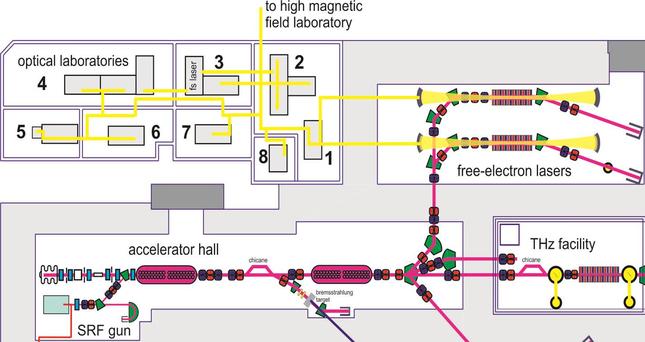FELBE
Operated by the Helmholtz-Zentrum Dresden-Rossendorf (HZDR), the free-electron-laser facility FELBE provides picosecond infrared pulses. Two free-electron lasers cover the mid- and far-infrared spectral range from 4 - 250 µm. The electron bunches for the FELBE are provided by the superconducting radio-frequency linear accelerator ELBE. FELBE can operate in three different modes:
Continuous pulsing with a repetition rate of 13 MHz, pulsing with 1 kHz by applying a pulse picker, and macrobunch operation with bunch length > 100 µs and macrobunch repetition rates ≤ 25 Hz. Pulse duration and pulse energy vary with wavelength and lie in the range from 1 - 25 ps and 100 nJ - few µJ, respectively.
The user labs at FELBE are equipped mainly for time-resolved spectroscopy. Various tabletop near-infrared and THz sources can be synchronised to FELBE and setups exist for single-colour and two-colour pump-probe experiments, time-resolved photoluminescence measurements, near-field spectroscopy, and Fourier-transform infrared spectroscopy. Samples can be studied in an 8 T split-coil magnet with optical access. Furthermore FELBE is linked to the Dresden High Magnetic Field Laboratory, which enables infrared spectroscopy in pulsed magnetic fields up to 70 T (150 ms magnetic pulse duration).
|
Beam parameters |
Value |
|---|---|
|
Photon energy [meV] |
5 - 300 |
|
Wavelength [µm] |
4 - 250 |
|
Polarization |
Linear; circular possible for some wavelengths |
|
Estimated pulse length [ps] |
1 - 25 |
|
Repetition rate [MHz] |
13, 1 KHz; also macrobunch (< 25 Hz) |
|
Pulse Energy [µJ] |
0.1 - 2 |
|
Peak power [MW] |
up to 1 |
|
Average power [W] |
up to 20 |
|
FEL mode |
TEM_00 |
|
FEL bandwidth [%] (FWHM) |
0.3 – 1.5 |

